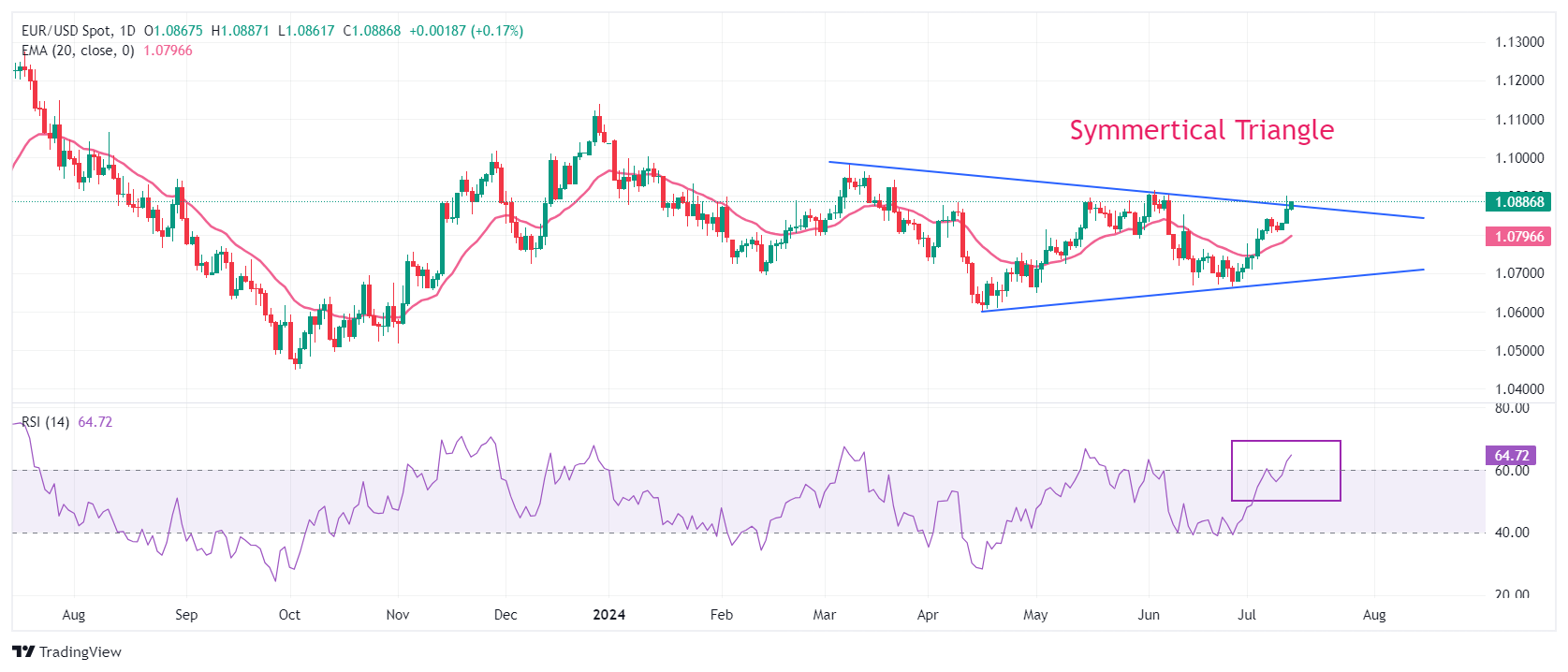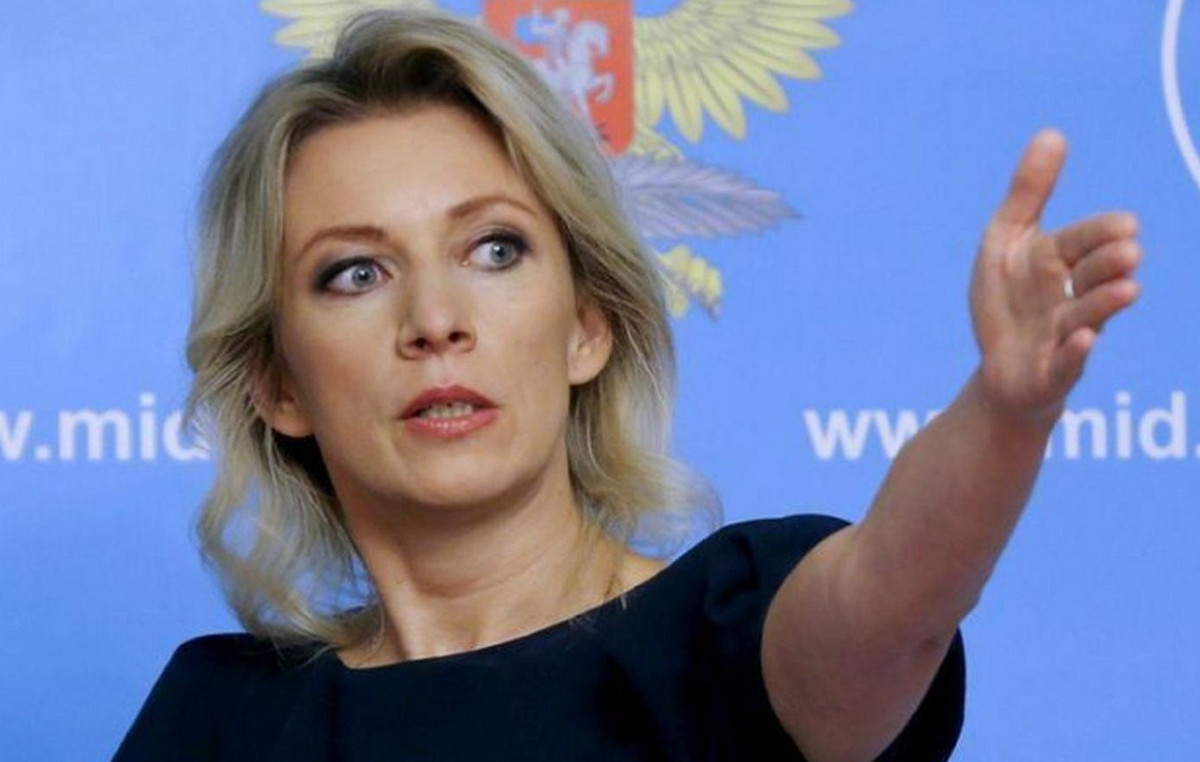- EUR/USD rises as weak US inflation reading boosts Fed rate cut outlook.
- A rate-cutting move by the Fed in September appears to be a fait accompli.
- The defeat of the far right has reduced the immediate risks of widening the French financial crisis.
EUR/USD is trading higher near 1.0880 during the European session on Friday. The major currency pair is gaining strength as fears of a financial crisis in the Eurozone’s second-largest nation are easing, and expectations of subsequent interest rate cuts by the European Central Bank (ECB) next week have brightened the outlook for the Euro.
The immediate risks of a financial crisis in France have diminished as Marine Le Pen’s far-right National Rally failed to maintain dominance over other parties. Economists were concerned that the far-right could increase fiscal spending if it came to power. However, uncertainty over the new fiscal policy framework remains high due to the expected coalition of French President Emmanuel Macron’s centrist alliance and the left, also known as the New Popular Front, led by Jean-Luc Mélenchon.
Meanwhile, expectations for subsequent ECB rate cuts have diminished as officials see price pressures remaining close to their current levels throughout the year. ECB policymakers have refrained from committing to a predefined rate cut path as they fear that an aggressive policy expansion could reignite price pressures again.
Daily Market Wrap: EUR/USD rises as far-right defeat brightens Euro outlook
- EUR/USD is up and trading near a fresh monthly high of 1.0900, recorded on Thursday. The short-term outlook for the shared currency pair is strengthening as investors expect an interest rate cut by the Federal Reserve (Fed) at the September meeting to be a done deal.
- According to the CME FedWatch tool, the central bank is confident of cutting interest rates in September and is also expected to make a subsequent rate cut at the November or December meeting. Expectations for Fed rate cuts have been boosted by the US Consumer Price Index (CPI) data for June, released on Thursday, which indicated that the disinflation process has resumed after a pause in the first quarter of this year.
- Annual core inflation, which is typically considered by Fed officials in making interest rate decisions because it excludes the volatile elements of food and energy, unexpectedly slowed to 3.3%. Economists had expected core inflation to have risen steadily by 3.4%. Overall inflation rose to 3.0%, the lowest reading in a year, due to declining energy and rent prices. Monthly headline inflation deflated by 0.1% after remaining unchanged in May.
- Easing inflation pressures in the U.S. and easing labor market conditions have boosted Fed officials’ confidence that inflation is on track to return to the desired 2% rate. San Francisco Fed President Mary Daly said on Thursday that a slowdown in inflation pressures is a “welcome relief” and strengthens the case for lower interest rates. However, the timing remains a matter of debate, Reuters reported.
- Improving Fed rate cut expectations are a negative development for the US Dollar (USD). The US Dollar Index (DXY), which tracks the value of the greenback against six major currencies, looks vulnerable near 104.40.
- Meanwhile, investors are awaiting the US Producer Price Index (PPI) data for June, due at 12:30 GMT. Producer inflation is expected to have grown at a higher pace both on a monthly and annual basis.
Technical Analysis: EUR/USD Prepares for a Triangle Breakout
EUR/USD is gaining strength to deliver a breakout of the Symmetrical Triangle formation on the daily time frame. The major currency pair is trading close to the descending border of the mentioned chart pattern around 1.0880, which is drawn from the high of March 8 at 1.0980. The ascending border of the triangle formation is marked from the low of April 16 around 1.0620.
The upsloping 20-day exponential moving average (EMA) near 1.0800 suggests that the short-term trend is bullish.
The 14-day Relative Strength Index (RSI) is set in the bullish range of 60.00-80.00, indicating that momentum has tilted to the upside.
Euro FAQs
The Euro is the currency of the 20 European Union countries that belong to the Eurozone. It is the second most traded currency in the world, behind the US Dollar. In 2022, it accounted for 31% of all foreign exchange transactions, with an average daily volume of over $2.2 trillion per day. EUR/USD is the most traded currency pair in the world, accounting for an estimated 30% of all transactions, followed by EUR/JPY (4%), EUR/GBP (3%) and EUR/AUD (2%).
The European Central Bank (ECB), based in Frankfurt, Germany, is the reserve bank of the Eurozone. The ECB sets interest rates and manages monetary policy. The ECB’s main mandate is to maintain price stability, which means controlling inflation or stimulating growth. Its main instrument is to raise or lower interest rates. Relatively high interest rates – or the expectation of higher rates – generally benefit the Euro and vice versa. The Governing Council of the ECB takes monetary policy decisions at meetings held eight times a year. Decisions are taken by the heads of the national banks of the Eurozone and six permanent members, including ECB President Christine Lagarde.
Eurozone inflation data, as measured by the Harmonised Index of Consumer Prices (HICP), is an important econometric data point for the euro. If inflation rises more than expected, especially if it exceeds the ECB’s 2% target, the ECB is forced to raise interest rates to bring inflation back under control. Relatively high interest rates compared to their peers usually benefit the euro, as it makes the region more attractive as a place for global investors to park their money.
Data releases measure the health of the economy and can influence the Euro. Indicators such as GDP, manufacturing and services PMIs, employment and consumer sentiment surveys can influence the direction of the single currency. A strong economy is good for the Euro. Not only does it attract more foreign investment, but it can encourage the ECB to raise interest rates, which will directly strengthen the Euro. Conversely, if economic data is weak, the Euro is likely to fall. Economic data from the four largest Eurozone economies (Germany, France, Italy and Spain) are especially significant, as they account for 75% of the Eurozone economy.
Another important output for the euro is the trade balance. This indicator measures the difference between what a country earns from its exports and what it spends on imports during a given period. If a country produces highly sought-after export products, its currency will appreciate due to the additional demand created by foreign buyers who wish to purchase these goods. Therefore, a positive net trade balance strengthens a currency and vice versa for a negative balance.
Source: Fx Street
I am Joshua Winder, a senior-level journalist and editor at World Stock Market. I specialize in covering news related to the stock market and economic trends. With more than 8 years of experience in this field, I have become an expert in financial reporting.








